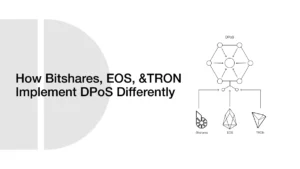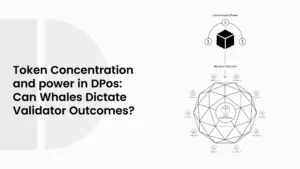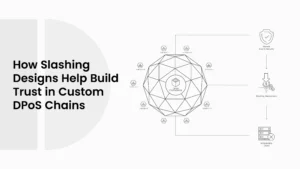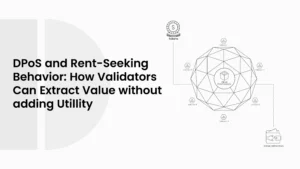Mastering DPoS: A Guide to Blockchain Governance and Teaching Tools

As blockchain technology becomes more prevalent in industries such as finance, supply chain, and public governance, colleges throughout the world are expanding their course offerings to include distributed ledger technologies. While initial modules frequently focus on Bitcoin and Ethereum, curricula must evolve to cover other consensus methods that enable more scalable and energy-efficient systems.
- Understanding DPoS: Key Concepts for Instruction
- How DPoS Voting Works: A Simple Step-by-Step Analogy
- Academic Resources for Teaching DPoS
- DPoS Lecture Slides and Visual Aids: What to Include
- Classroom Activities and Teaching Approaches
- Common Challenges in Teaching DPoS and How to Address Them
- Suggested Research Questions
- The Final Word
- Frequently Asked Questions (FAQs)
- Glossary of Key Terms
One such paradigm is Delegated Proof of Stake (DPoS), a consensus mechanism that combines performance, community governance, and democratic delegation. The blockchain mechanism DPoS, which underlies platforms like EOS, TRON, and Steem, demonstrates how it is possible to achieve real-time blockchain performance while maintaining participatory governance. For teachers, incorporating DPoS into the academic curriculum will also lead to important discussions on trade-offs between decentralization, security, and scalability. This is the future of DPoS.
Understanding DPoS: Key Concepts for Instruction
| Feature | PoW (Bitcoin) | PoS (Cardano) | DPoS (EOS/TRON) |
| Energy Usage | Very High | Low | Very Low |
| Validator Selection | Mining | Stake-based | Voted delegates |
| Finality Speed | Slow | Moderate | Fast |
| Governance Style | None | Proposal Model | Representative |
| Scalability | Low | Moderate | High |
The DPoS consensus mechanism, a variant of Proof of Stake (PoS), integrates representative democracy with blockchain governance. DPoS uses a delegate voting method, as opposed to normal PoS, which allows any user with a stake to participate in validating blocks. Token holders vote to elect a small number of block producers, or delegates, who are responsible for confirming transactions and maintaining the blockchain.
ALSO READ: From Elections to Blockchain: How DPoS Works in the Real World
Its selection mechanism is dynamic. The token holders will be able to vote in real time and can reassign their votes in case of poor performance or dishonesty by the delegates, which makes them accountable to the community through constant monitoring and supervision. Most DPoS systems have 21-30 block producers that rotate in the block production at a fixed interval, resulting in rapid finality, high throughput, and low latency. Planned block times and predictable block assignments enable the consensus process to be controlled, rather than being rendered much more unpredictable, as in Proof of Work.
| Consensus Model | Decentralization | Scalability | Security | Teaching Difficulty |
| PoW | High | Low | Very High | Medium |
| PoS | Medium | Medium | High | Medium |
| DPoS | Lower | High | Good | Easier |
Pedagogically, it is helpful to contrast DPoS to PoW and PoS systems. PoW encourages security by the use of energy, and PoS security by the commitment of capital, but DPoS focuses on efficiency and democracy. Learning these tradeoffs can give students a balanced understanding of the reasons why blockchain systems provide the desired properties in the trilemma of scalability: decentralization, scalability, and security.
From a teaching standpoint, DPoS is often more accessible than traditional PoS. Whereas PoS necessitates that students learn about staking, rewards to validators, and rewards at the protocol level, DPoS can be explained with the help of a real-world analogy, such as representative elections. The voting-based model not only justifies classroom simulations but also emphasizes democratic processes and accountability, which are more accessible to students in undergraduate and high school. In essence, DPoS turns blockchain into something you can actually engage with, rather than just discuss.
How DPoS Voting Works: A Simple Step-by-Step Analogy
| Step | What It Means |
| Cast a Vote | Token holder selects delegates |
| Delegate Elected | Begins block validation |
| Delegate Underperforms | Voters can revoke support |
| Vote Again | Reassign votes to new delegate |
ALSO READ: Understanding DPoS Through Everyday Analogies
Imagine your school is holding an election for class representatives. Here’s how it mirrors DPoS:
- Everyone Gets a Vote: If you own tokens (like students in a class), you can vote.
- Vote for Delegates: Instead of doing the work yourself, you vote for someone you trust to make decisions (like choosing a class rep).
- Elected Delegates Do the Job: These chosen block producers validate transactions, just like your class rep speaks for the class.
- Vote Again Anytime: If you feel they’re not doing a good job, you can vote them out and choose someone else.
Academic Resources for Teaching DPoS
| Resource Type | Example | Level | Best Use | Access Format |
| Whitepaper | EOS Technical Whitepaper | Advanced | Technical deep dive into DPoS mechanics | PDF, Web |
| Academic Journal | IJIC 2024 on DPoS Throughput | University-level | Case-based analysis, citations | |
| Explainer Article | Cointelegraph: “DPoS Explained” | Beginner–Intermediate | Introduce DPoS in an accessible way | Web |
| Industry Blogs | DPoS | Intermediate | Real-world examples and applications | Web |
| GitHub Repositories | EOSIO GitHub | Developer-level | Code-based instruction | Open-source code |
Access to reliable and academically rigorous resources is critical for effective teaching. While DPoS is underrepresented in traditional computer science courses, a growing body of peer-reviewed and industry-based research demonstrates its utility in advanced blockchain curricula.
The EOS Technical Whitepaper, which describes the DPoS architecture and scheduling algorithm, is a recommended academic resource. Instructors may also use readily available explainers from reputable industry sources. Blogs about concepts of DPoS provide a comprehensible but technically sound introduction for undergraduate students.
These tools allow instructors to present DPoS as more than just a “faster alternative” to PoW but as a governance-aware, efficiency-oriented consensus framework applicable to a variety of real-world applications.
DPoS Lecture Slides and Visual Aids: What to Include
When designing a DPoS lecture, clarity and structure are essential. A well-organized PowerPoint deck should begin with a clear definition of the consensus algorithm, followed by architecture diagrams and comparative analysis. A high-level flow diagram can illustrate how token holders elect delegates and how block producers rotate to validate transactions.
Include the comparison of PoW, PoS, and DPoS by the amount of energy spent, the average length of the block, the level of decentralization, and governance. Even charts and timelines that demonstrate the differences between block production intervals of various systems (e.g., 0.5-second blocks by EOS vs. 10-minute blocks by Bitcoin) can illustrate the performance benefits of DPoS.
Where possible, teachers are encouraged to incorporate video clips, GIFs, and/or slide transition interactions that demonstrate how voting can be performed and how delegates can be brought in and out depending on the community’s response.
Classroom Activities and Teaching Approaches
| Role | Material Needed | Function in Simulation |
| Token Holder | Tokens or ballots | Vote for delegates |
| Delegate Candidate | Forms/Speeches | Campaign |
| Block Producers | Top voted list | Create blocks |
| Observers | Checklists | Ensure fairness |
Interactive training is essential for ensuring that students understand the implications of DPoS mechanics, rather than merely memorizing them. One good technique is to hold a classroom simulation of a DPoS election. Students can be issued tokens (either paper slips or a digital voting mechanism), nominate themselves as candidates, and campaign for votes. The elected delegates then create the “block producer group” and carry out simulated transaction validation.
Such simulations reinforce the principles of stakeholder voting, delegation accountability, and achieving consensus through limited participation. Additionally, instructors can assign case-based group discussions based on disputes in existing DPoS networks. For example, the 2019 EOS debate over vote trading and block producer collusion can be used as a case study in governance failure and ethical risk.
ALSO READ: How DPoS Can Save Crypto’s Environmental Reputation
Moreover, students have the opportunity to gain experience with the future of DPoS, as data-driven tasks, such as on-chain voter analysis on TRON or EOS in a block explorer, allow for an understanding of blockchain governance patterns. Long-term recollection enhancement is facilitated through quizzes, reflective essays, and mini-research projects, considering consensus trade-offs (such as speed versus decentralization).
Common Challenges in Teaching DPoS and How to Address Them
Despite its merits, teaching DPoS provides certain instructional obstacles. Students may confuse DPoS with regular PoS due to their shared reliance on token ownership, which can lead to confusion about validation privileges and governance roles. To mitigate this, educators should emphasize that DPoS establishes a representational layer in which token ownership confers voting rights, rather than direct validation rights.
Abstract notions, such as stake-weighted voting, block producer rotation, and deterministic finality, can also be conceptually challenging. One approach is to start the discussion using common comparisons, such as student council elections, before moving on to formal definitions. By first establishing a conceptual foundation in democratic decision-making, educators can gradually build upon technical complexities.
Moreover, learners may encounter issues with the ethical aspects of DPoS, specifically the risks of centralization, voter apathy, and delegate collusion. The subjects cannot be removed from technical training, but they must be integral to the critical elements of building blockchain governance literacy.
Suggested Research Questions
For blockchain students, DPoS presents an opportunity to explore research questions that are both academically rigorous and practically relevant. Here are a few directions to explore:
| Category | Research Question |
| Governance | How do different voting mechanisms (e.g., 1 token = 1 vote vs quadratic voting) impact delegate accountability and voter turnout? |
| Security | What mechanisms can prevent long-term delegate collusion without sacrificing throughput? |
| Game Theory | How can incentives be structured to prevent low-performance delegates from getting re-elected? |
| User Behaviour | What psychological or behavioural factors influence voter apathy in DPoS systems, and how can gamification reverse that trend? |
| Scalability vs Decentralization | Can dynamically rotating validators provide better decentralization while maintaining performance? |
| Cross-Chain Applications | How can Delegated Proof of Stake mechanisms adapt to an interoperable, multi-chain future without compromising governance consistency? |
| Transparency and Trust | What role does transparency of delegate actions (e.g., public dashboards, track records) play in building long-term trust in DPoS ecosystems? |
The Final Word
| Blockchain | Governance Mechanism | Real-World Example |
| EOS | Referendum Voting | Token holders voted on fee structures and upgrades. |
| TRON | Super Representative Proposals | Proposal 22 restructured resource distribution. |
| Steem | Block Producer Voting | 2020 dispute led to Hive fork after centralization resistance. |
The addition of Delegated Proof of Stake in academic blockchain curricula provides students with a more nuanced knowledge of how performance, governance, and decentralization interact in distributed systems. As blockchain systems evolve, consensus methods such as DPoS will become increasingly important, not only technically, but also in terms of their future applications.
Through the use of carefully selected learning materials, visually appealing information, and interactive learning approaches, teachers can foster a deeper understanding of Delegated Proof of Stake and its practical applications. Not only do the students learn how DPoS functions, but they also gain valuable insights into its trade-offs, weaknesses, and strengths. This will mean that the generation of blockchain developers, analysts, and policymakers will be more informed in the future.
Universities are well-positioned to standardize Delegated Proof of Stake as a fundamental component of blockchain education, ensuring that students understand not only how blockchains work but also how they are controlled, scaled, and shaped through communal involvement.
Frequently Asked Questions (FAQs)
- What is Delegated Proof of Stake in blockchain education?
Delegated Proof of Stake is a consensus algorithm where users vote for a small group of block producers who validate transactions on a blockchain. It’s commonly taught in advanced blockchain courses for its scalability and governance features.
- Why should universities include Delegated Proof of Stake in the curriculum?
Because DPoS powers real-world platforms like EOS and TRON, teaching it gives students exposure to newer consensus models beyond Bitcoin’s Proof of Work.
- What makes Delegated Proof of Stake different from PoS or PoW?
Delegated Proof of Stake uses community-elected delegates to verify transactions, whereas PoW uses computation and PoS uses direct staking. DPoS is faster and more energy-efficient.
- Are there good case studies on Delegated Proof of Stake to use in class?
Yes. The EOS vote-trading controversy and TRON’s Super Representative model are both valuable case studies in governance ethics and scalability.
Glossary of Key Terms
- Delegated Proof of Stake: A consensus method where token holders vote for delegates to validate transactions.
- Block Producers: The few elected delegates who create and verify blocks on a blockchain.
- Token Holders: Users who own cryptocurrency on the blockchain and use it to vote.
- Governance: The system by which decisions and changes are made in a blockchain network.
- Stake-weighted Voting: Voting where users with more tokens have greater influence.
- Finality: The point at which a transaction is considered permanent and irreversible.
- Scalability: A blockchain’s ability to handle increased user and transaction loads.
- PoW (Proof of Work): A consensus system that uses computing power to validate transactions.
- PoS (Proof of Stake): A system where validators are selected based on how many tokens they stake.




